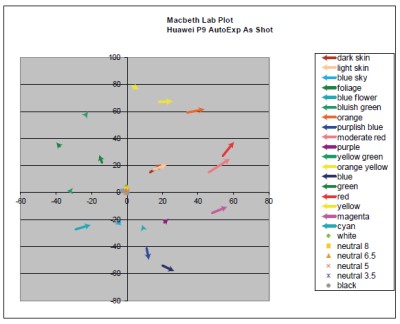articles/Review/huaweip9-page1
Huawei P9 Smart Phone - part 1 of 1 2 3
by Mike McNamee Published 01/07/2016

Camera phones are not things we normally conduct reviews on but this one piqued our interest because it carries an endorsement from Leica, along with an unusual approach to image capture. The P9's signature features are the two 12-megapixel Sony 12MP IMX286 sensors that are paired with Leica Summarit H 1:2.2/27 lenses sporting an f/2.2 aperture and 27mm focal length. One sensor captures data in full RGB colour, while the other captures just monochrome.
This is an interesting take on the usual Bayer filter arrangement of red-green-red-green and blue-greenblue-green array arrangement which aims to maximise the information in the luminance channel by exploiting the extra image detail in the green part of the spectrum (via a double number of green filtered detectors). Adding an all monochrome sensor into the mix presumably enhances the effect further although the excitation of each 1.25μm pixel will depend upon the wavelength falling on it. Apparently, using two lenses isn't a new idea-HTC's M8 did the same thing back in 2014, and LG's G5 has two cameras too-but Huawei's implementation is slightly different. The ISO ranges 50-3200.
The claims are that the 5.2in Full HD LCD display delivers a resolution of 1920x1080 pixels (424ppi), with 96 percent colour saturation (whatever than means) and 500 nits of brightness. For our part we simply treated the device like an SLR and ran it through our standard testing regimes. That said, the on-screen images looked very perky.

Technically the images are over-saturated and over-contrasty compared with perfect reproduction of a Macbeth Chart. This might be just what the average punter yearns for, we are not talking scientific or product photography here! The average error across a Macbeth ColorChecker 24 using an uncorrected, as-shot image was 6.6ΔEoo, modest but not a disaster. The image was almost perfectly exposed, less than .05 stops out and within 2 RGB points of neutrality. We applied a curve to bring the mid-tones, shadows and highlights to the correct Macbeth aim values and in so doing reduced the average error to 3.6ΔEoo. The main errors in the statistics were in the lightness channel (6.73ΔLoo) then the saturation (4.93ΔCoo - too saturated) and then the hue (2.61ΔHoo). Overall then, in terms of colour, the camera performs quite well for the tasks it would ordinarily be set. A Raw file option is available which creates a DNG file which would give a more control.
You are currently on page 1 Contact Mike McNamee
1st Published 01/07/2016
last update 09/12/2022 14:55:04
More Review Articles
There are 16 days to get ready for The Society of Photographers Convention and Trade Show at The Novotel London West, Hammersmith ...
which starts on Wednesday 14th January 2026




